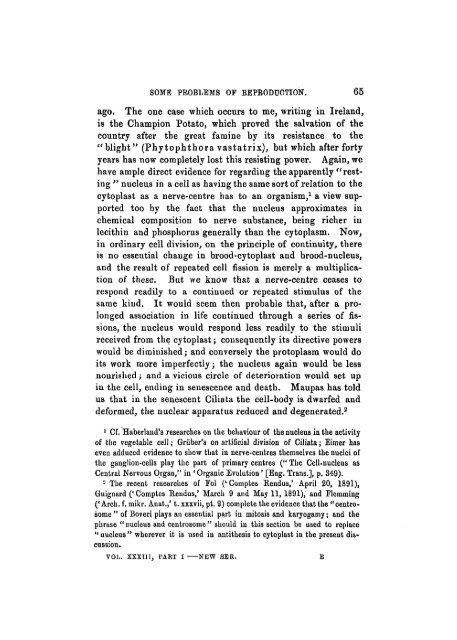Some Problems of Reproduction: a Comparative Study of ...
Some Problems of Reproduction: a Comparative Study of ...
Some Problems of Reproduction: a Comparative Study of ...
Create successful ePaper yourself
Turn your PDF publications into a flip-book with our unique Google optimized e-Paper software.
SOME PROBLEMS OF EEPRODUOTION. 65<br />
ago. The one case which occurs to me, writing in Ireland,<br />
is the Champion Potato, which proved the salvation <strong>of</strong> the<br />
country after the great famine by its resistance to the<br />
"blight" (Phytophthora vastatrix), but which after forty<br />
years has now completely lost this resisting power. Again, we<br />
have ample direct evidence for regarding the apparently "resting<br />
" nucleus in a cell as having the same sort <strong>of</strong> relation to the<br />
cytoplast as a nerve-centre has to an organism, 1 a view supported<br />
too by the fact that the nucleus approximates in<br />
chemical composition to nerve substance, being richer in<br />
lecithin and phosphorus generally than the cytoplasm. Now,<br />
in ordinary cell division, on the principle <strong>of</strong> continuity, there<br />
is no essential chauge in brood-cytoplast and brood-nucleus,<br />
and the result <strong>of</strong> repeated cell fission is merely a multiplication<br />
<strong>of</strong> these. But we know that a nerve-centre ceases to<br />
respond readily to a continued or repeated stimulus <strong>of</strong> the<br />
same kind. It would seem then probable that, after a prolonged<br />
association in life continued through a series <strong>of</strong> fissions,<br />
the nucleus would respond less readily to the stimuli<br />
received from the cytoplast; consequently its directive powers<br />
would be diminished; and conversely the protoplasm would do<br />
its work more imperfectly; the nucleus again would be less<br />
nourished; and a vicious circle <strong>of</strong> deterioration would set up<br />
in the cell, ending in senescence and death. Maupas has told<br />
us that in the senescent Ciliata the cell-body is dwarfed and<br />
deformed, the nuclear apparatus reduced and degenerated. 8<br />
1 Cf. Haberland's researches on the behaviour <strong>of</strong> the nucleus in the activity<br />
<strong>of</strong> the vegetable cell; Griiber's on artificial division <strong>of</strong> Ciliata; Eimer has<br />
even adduced evidence to show that in nerve-centres themselves the nuclei <strong>of</strong><br />
the ganglion-cells play the part <strong>of</strong> primary centres (" The Cell-nucleus as<br />
Central Nervous Organ," in 'Organic Evolution' [Bng. Trans.], p. 349).<br />
" The recent researches <strong>of</strong> Fol (' Comptes Rendus, 1 April 20, 1891),<br />
Guignard (' Comptes Rendus,' March 9 and May 11,1891), and Flemming<br />
('Arch. f. mikr. Anat.,' t. xxxvii, pt. 2) complete the evidence that the "centrosome<br />
" <strong>of</strong> Boveri plays an essential part in mitosis and karyogamy; and the<br />
phrase "nucleus and centrosome" should in this section be used to replace<br />
" nucleus" wherever it is used in antithesis to cytoplast in the present discussion.<br />
VOJ,. XXXIII, PART I NEW SEE. E

















